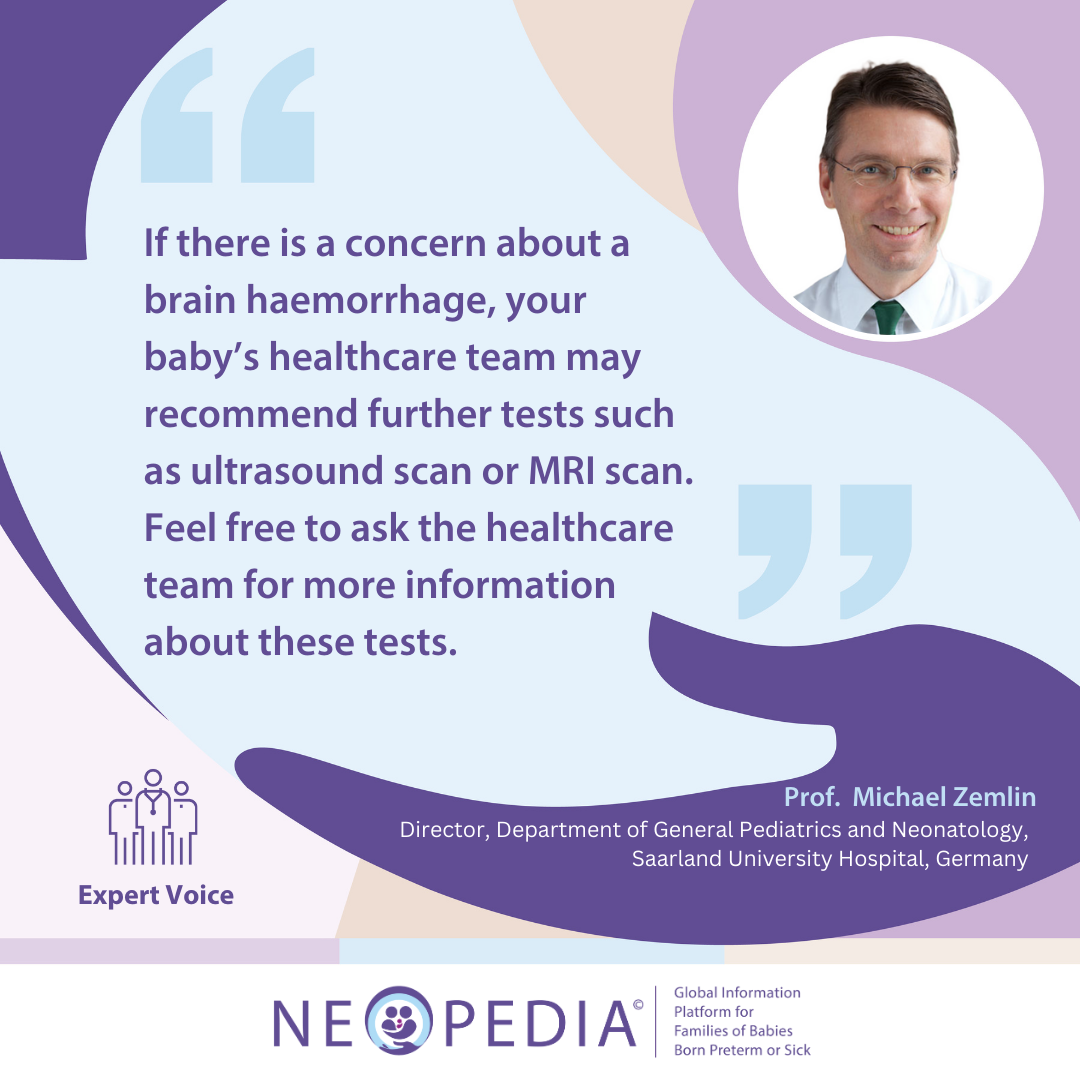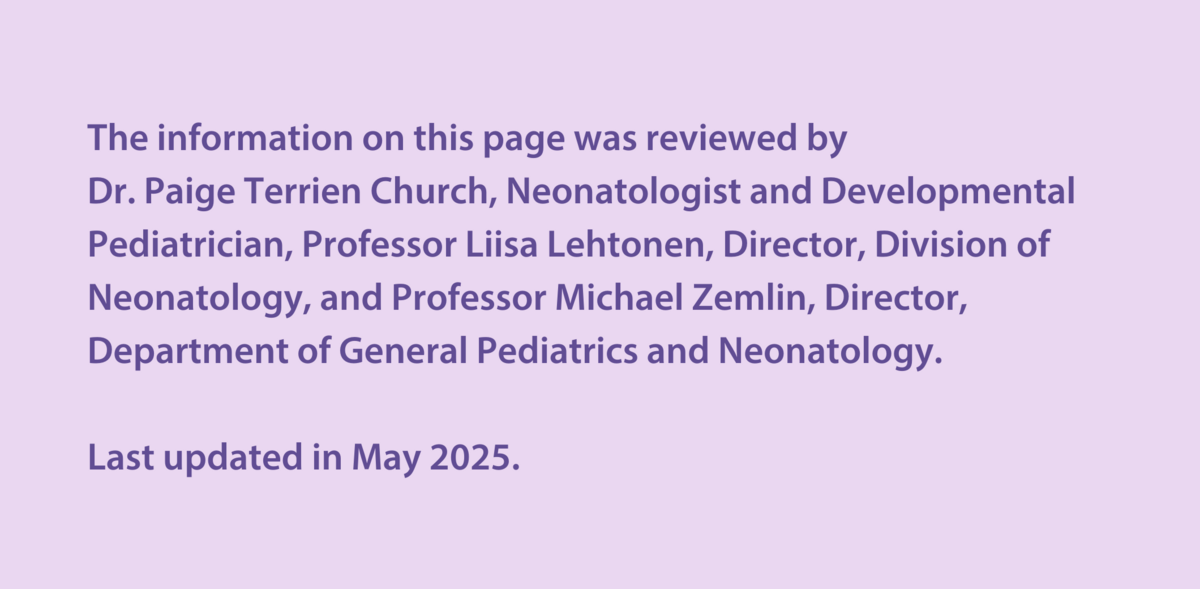Please consider reading the information that is relevant to you and your little one(s). By doing so, you can avoid overwhelming yourself with too much information in an already distressing time.

The brain, like the rest of the body, needs oxygen to work properly. Blood carries oxygen to the brain through tiny blood vessels. If something goes wrong with these blood vessels, it can cause damage to the brain through bleeding or a lack of blood flow.
In preterm babies, the brain and its blood vessels are still developing, making them fragile. The brain contains fluid-filled spaces called ventricles, and sometimes blood can leak into these spaces from the delicate vessels, a condition known as intraventricular hemorrhage (IVH). Severe IVH can damage the surrounding brain tissue.
The risk for severe IVH is significant in babies born below 25 weeks of gestation⍰. It typically happens within the first few days after birth but can happen before, during, or shortly after birth if the baby becomes unwell.
Preterm babies are at higher risk, especially if they have unstable blood pressure⍰, breathing difficulties requiring a ventilator⍰, have infections, blood clotting issues, or conditions like respiratory distress syndrome (RDS)⍰.
Many babies with IVH show no symptoms, and it is often detected during routine ultrasound⍰ scans of the head. Otherwise, symptoms could include reduced activity, decreased alertness, signs of pain, unusual movements or seizures⍰, swelling of the soft spots on the head, and irregular breathing. Babies showing symptoms are more likely to have more serious bleeding. If IVH is detected, doctors will perform scans to monitor progress and assess any potential lasting damage to the brain.
There is no specific treatment for IVH, but the blood gradually goes away over several weeks. The neonatal team will provide the necessary care and monitor the baby’s progress and check if any harm was done to the brain tissues.
Periventricular leukomalacia (PVL) might develop in the context of or independently of IVH, however, severe PVL is uncommon nowadays. It is a condition where the white matter around the brain's ventricles is damaged. This white matter is crucial for transmitting information between nerve cells, the spinal cord⍰, and different brain regions. PVL can harm the nerve pathways that control motor movements, leading to tight, spastic, or weak muscles. Babies with PVL have a greater possibility of developing cerebral palsy⍰ and may experience learning difficulties and other developmental issues.
Follow-up care after the NICU for babies who have experienced IVH or PVL includes going to neurological development follow-up centers for regular check-ups and providing therapies, to support their development. These measures are crucial for managing potential issues and promoting the best possible outcomes.
Read more about follow-up care after the NICU.

A brain hemorrhage can sometimes happen during or shortly after birth in full-term babies. This is best described as bleeding around the brain rather than inside the brain tissue, which is important to note. Bleeding within the brain tissue itself is less common and often happens due to differences in the blood vessels or a blockage (clot) that cuts off blood flow to part of the brain. The most common types are subarachnoid hemorrhages⍰ and subdural hemorrhages⍰, while other types, like IVH, are less frequent. Often, the exact cause is unknown, but it may be due to the natural pressures on your baby’s head during vaginal birth. Factors that can increase the risk include breech delivery, meaning a baby born bottom first, the use of forceps⍰ or suction during delivery, and conditions like hemophilia⍰ or low platelets⍰.
Most full-term babies with a brain hemorrhage show no immediate signs. If symptoms do appear, they usually manifest within two or three days and can include:
In many cases, the bleeding stops without treatment. Your baby may need care in the neonatal unit if they are unwell, and rarely, surgery may be necessary to drain the blood. Most full-term babies recover well from a brain hemorrhage. Long-term effects depend on the severity and location of the bleeding. Some children may develop conditions like cerebral palsy⍰, learning difficulties, or epilepsy⍰.
Hypoxic-ischemic encephalopathy (HIE) occurs when a baby's brain does not get enough oxygen or blood flow around birth, a condition called perinatal asphyxia, which is more frequent in mature than in preterm babies. The effects can extend to other organs like the lungs, liver, heart, bowel, and kidneys. HIE severity is graded as mild, moderate, or severe. Severe cases can result in long-term disability⍰ or in most serious cases even loss of life. Causes may include poor blood flow in the placenta⍰, and in rare cases complications during birth like placental abruption⍰.
Babies with mild HIE usually recover quickly with close monitoring. A treatment called therapeutic hypothermia may be used, which involves cooling the baby's temperature for 72 hours to reduce brain damage risk. Remember, you can always talk to your baby's healthcare team for more information or if you have any questions.

